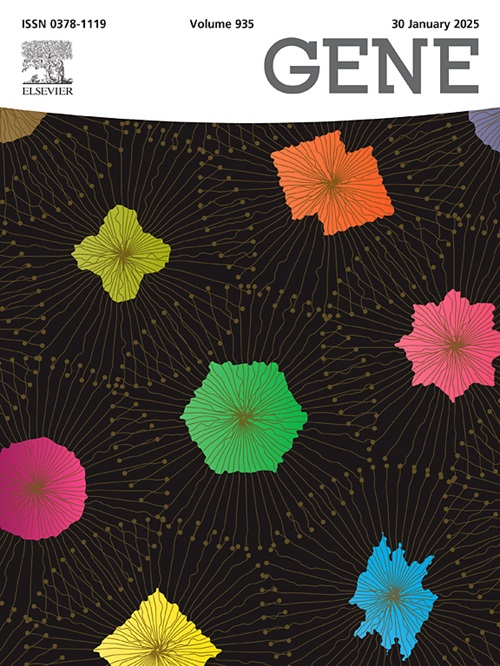DIP2C缺乏导致10p15.3微缺失综合征患者出现先天性心脏缺陷
IF 2.4
3区 生物学
Q2 GENETICS & HEREDITY
引用次数: 0
摘要
复发性10p15.3微缺失综合征是一种罕见的多系统疾病,以面部特征异常、整体发育迟缓(DD)/智力残疾(ID)、身材矮小、手足畸形和先天性心脏缺陷(CHDs)为特征。然而,导致心脏表型的特定遗传缺陷仍不清楚。方法探讨10p15.3微缺失综合征并发冠心病的遗传原因。通过反义morpholino oligonucleotide (MO)介导斑马鱼dip2ca的下调和斑马鱼的救援实验,观察dip2ca在调节心脏生长中的作用。对dip2ca-MO组与对照组进行表达谱分析。结果我们报告了一名男性先证患者,其面部外观独特,异斜视,全局DD/ID,先天性马蹄内翻(CTEV)和房间隔缺损(ASD),其新生微缺失6.44 Mb重叠10p15.3。我们通过回顾10p15.3微缺失病例,并进行候选基因功能分析,确定Disco相互作用蛋白2同源基因C (DIP2C)可能是冠心病的候选基因。在斑马鱼中,mo介导的dip2ca的下调导致与10p15.3范围一致的发育缺陷,相关的人类表型包括体长缩短、颅面畸形和心脏缺陷,包括心包水肿、线状心管、环状缺陷和心律失常。野生型dip2ca mRNA与dip2ca- mo共注射部分挽救了这些检测。转录组分析显示斑马鱼foxj1a在dip2ca-MO斑马鱼中表达增加,并与心环有关。结论本研究拓展了对10p15.3微缺失综合征致病遗传因素的认识,提示DIP2C在心脏发育,特别是在心脏环方面发挥重要作用。本文章由计算机程序翻译,如有差异,请以英文原文为准。
The deficiency of DIP2C leads to congenital heart defects in patients with 10p15.3 microdeletion syndrome
Background
Recurrent 10p15.3 microdeletion syndrome is a rare multisystem disorder characterized by abnormal facial features, global developmental delay (DD)/intellectual disability (ID), short stature, hand/foot malformation, and congenital heart defects (CHDs). However, the specific genetic defects that contribute to the cardiac phenotype remain unclear.
Methods
We explored the genetic cause of CHDs in 10p15.3 microdeletion syndrome. Antisense morpholino oligonucleotide (MO)-mediated knockdown of dip2ca in zebrafish and rescue experiments in zebrafish were conducted to observe the role of dip2ca in regulating cardiac growth. Expression profile analysis was conducted between the dip2ca-MO group and the control group.
Results
We report one male proband presenting a distinctive facial appearance, heterotropia, global DD/ID, congenital talipes equinovarus (CTEV), and atrial septal defect (ASD), who had a de novo 6.44 Mb microdeletion overlapping 10p15.3. We identified Disco Interacting Protein 2 Homolog C (DIP2C) as a putative candidate gene underlying CHDs by reviewing the 10p15.3 microdeletion cases with or without CHDs and performing candidate gene functional analysis. MO-mediated knockdown of dip2ca in zebrafish resulted in developmental defects consistent with the range of 10p15.3-associated human phenotypes include decreased body length, craniofacial malformations, and heart defects, including pericardial edema, a linear heart tube, looping defects, and arrhythmia. Coinjection of wild-type dip2ca mRNA with dip2ca-MO partially rescued these detects. Transcriptome analysis revealed the expression of zebrafish foxj1a increased in the dip2ca-MO zebrafish and was associated with cardiac looping.
Conclusions
This study expands the understanding of pathogenic genetic factors involved in 10p15.3 microdeletion syndrome and suggests that DIP2C plays an important role in heart development, especially with respect to cardiac looping.
求助全文
通过发布文献求助,成功后即可免费获取论文全文。
去求助
来源期刊

Gene
生物-遗传学
CiteScore
6.10
自引率
2.90%
发文量
718
审稿时长
42 days
期刊介绍:
Gene publishes papers that focus on the regulation, expression, function and evolution of genes in all biological contexts, including all prokaryotic and eukaryotic organisms, as well as viruses.
 求助内容:
求助内容: 应助结果提醒方式:
应助结果提醒方式:


